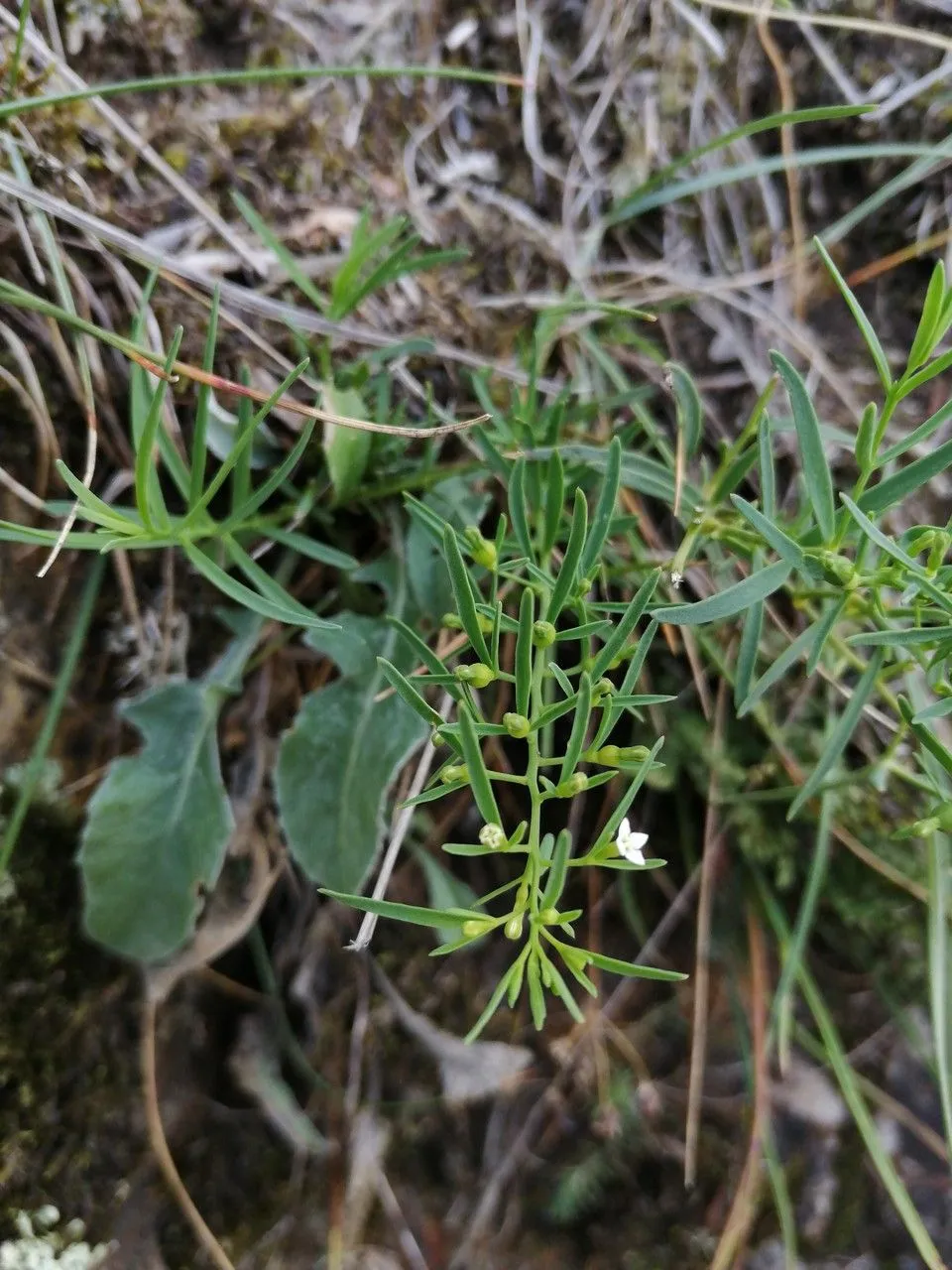
Author: L.
Bibliography: Sp. Pl.: 207 (1753)
Year: 1753
Status: accepted
Rank: species
Genus: Thesium
Vegetable: False
Observations: Europe to Iran
Alpine bastard-toadflax, scientifically known as Thesium alpinum, is a fascinating perennial herb belonging to the Santalaceae family. First described in 1753 by the renowned botanist Carl Linnaeus, this plant has captivated botanists and nature enthusiasts alike for centuries.
Found extensively throughout Europe and stretching as far as Iran, Thesium alpinum thrives in alpine and subalpine environments, exemplifying the resilience and adaptability of plant life in challenging conditions. This species typically grows in well-drained, rocky soils and often occupies meadows and grasslands at high altitudes, where it forms part of the intricate tapestry of alpine flora.
The Alpine bastard-toadflax is characterized by its slender, erect stems, which can reach heights of up to 30 centimeters. The plant’s leaves are narrow, linear, and usually arranged alternately along the stem. One of the distinguishing features of Thesium alpinum is its small, star-shaped flowers, which are typically white or pale green. These blossoms cluster together in terminal spikes or racemes, adding a delicate beauty to the rugged landscapes in which the plant is found.
As a member of the Santalaceae family, Thesium alpinum engages in a fascinating parasitic relationship with other plants. It is a hemiparasite, meaning it can photosynthesize to produce its own food but also derives some nutrients by attaching to the roots of neighboring plants. This dual strategy allows it to survive in nutrient-poor, high-altitude soils where other plants might struggle.
Despite its somewhat inconspicuous appearance, the Alpine bastard-toadflax plays a crucial role in its ecosystem. By participating in complex ecological networks, it contributes to the biodiversity and stability of alpine environments. Moreover, its presence can serve as an indicator of healthy, undisturbed habitats, making it a subject of interest for conservation efforts.
Overall, Thesium alpinum is a remarkable example of botanical adaptation and ecological significance. Its ability to persist across a wide geographical range, from the rugged slopes of Europe to the diverse landscapes of Iran, highlights its resilience and the intricate interdependencies within alpine ecosystems.
Dan: alpe-nålebæger
Deu: alpen-leinblatt
Lav: alpu linlape
Swe: spindelört, vanlig spindelört
Nob: trådurt
Nno: trådurt
En: Alpine Bastard-toadflax
Ca: Tèsium alpí
Da: Alpe-nålebæger
Nl: Alpenbergvlas
Fi: Ketohämähäkinruoho
Fr: Thésium des Alpes, Thésion des Alpes, Théson des Alpes
De: Alpen-Leinblatt, Gemeiner Bergflachs
It: Linaiola alpina, Linajola alpina
Lv: Alpu linlape
Nb: Trådurt
Nn: Trådurt
Sv: Spindelört, Vanlig spindelört
: Alpine bastard-toadflax
Taken Jul 6, 2015 by Tela Botanica − Yoan MARTIN (cc-by-sa)
Taken Jul 6, 2015 by Tela Botanica − Yoan MARTIN (cc-by-sa)
Taken Jun 4, 2016 by Tela Botanica − John DE VOS (cc-by-sa)
Taken May 26, 2022 by Ingo Brandt (cc-by-sa)
Taken May 20, 2021 by Mallol Camprubí Albert (cc-by-sa)
Taken Jun 5, 2022 by Werner Rom (cc-by-sa)
Taken May 8, 2017 by Yoan MARTIN (cc-by-sa)
Taken May 27, 2012 by Tela Botanica − Yoan MARTIN (cc-by-sa)
Taken Jun 4, 2016 by Tela Botanica − John DE VOS (cc-by-sa)
Taken Oct 19, 2021 by Mallol Camprubí Albert (cc-by-sa)
Taken Jul 15, 2012 by Tela Botanica − Yoan MARTIN (cc-by-sa)
Taken Aug 23, 2017 by Tela Botanica − Liliane ROUBAUDI (cc-by-sa)
Taken Aug 7, 2016 by Tela Botanica − Yoan MARTIN (cc-by-sa)
Taken Aug 7, 2016 by Tela Botanica − Yoan MARTIN (cc-by-sa)
Taken Aug 7, 2016 by Tela Botanica − Yoan MARTIN (cc-by-sa)
Taken Jun 24, 2007 by Tela Botanica − La Spada ARTURO (cc-by-sa)
Taken Aug 7, 2016 by Tela Botanica − Yoan MARTIN (cc-by-sa)
Taken Jul 15, 2012 by Tela Botanica − Yoan MARTIN (cc-by-sa)
Taken Jul 25, 2012 by Tela Botanica − Hugues TINGUY (cc-by-sa)
Taken Jun 10, 2016 by Tela Botanica − Liliane ROUBAUDI (cc-by-sa)
Taken Jul 1, 2017 by Tela Botanica − La Spada ARTURO (cc-by-sa)
Taken Jan 1, 1800 by Tela Botanica − La Spada ARTURO (cc-by-sa)
Taken Aug 7, 2016 by Tela Botanica − Yoan MARTIN (cc-by-sa)
Taken Jun 10, 2016 by Tela Botanica − Liliane ROUBAUDI (cc-by-sa)
Taken Jul 6, 2015 by Tela Botanica − Yoan MARTIN (cc-by-sa)
Taken May 27, 2012 by Tela Botanica − Jean-Claude CALAIS (cc-by-sa)
Taken Jul 15, 2012 by Tela Botanica − Yoan MARTIN (cc-by-sa)
Taken Jun 4, 2016 by Tela Botanica − John DE VOS (cc-by-sa)
Taken Jun 4, 2016 by Tela Botanica − John DE VOS (cc-by-sa)
Ph maximum: 8.0
Ph minimum: 7.5
Light: 8
Atmospheric humidity: 4
Soil nutriments: 2
Family: Myrtaceae Author: (F.Muell.) K.D.Hill & L.A.S.Johnson Bibliography: Telopea 6: 402 (1995) Year: 1995 Status:…
Family: Rubiaceae Author: Pierre ex A.Froehner Bibliography: Notizbl. Bot. Gart. Berlin-Dahlem 1: 237 (1897) Year:…
Family: Sapindaceae Author: Koidz. Bibliography: J. Coll. Sci. Imp. Univ. Tokyo 32(1): 38 (1911) Year:…
Family: Asteraceae Author: A.Gray Bibliography: Pacif. Railr. Rep.: 107 (1857) Year: 1857 Status: accepted Rank:…
Family: Fabaceae Author: Medik. Bibliography: Vorles. Churpfälz. Phys.-Ökon. Ges. 2: 398 (1787) Year: 1787 Status:…
Family: Aspleniaceae Author: (Cav.) Alston Bibliography: Bull. Misc. Inform. Kew 1932: 309 (1932) Year: 1932…